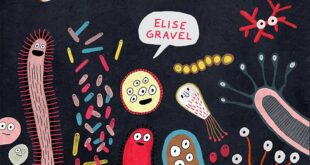Michael DeForge’s Big Kids from Drawn & Quarterly is aptly named with a title that may seem simple at first read, although it gives a scope of the human condition upon understanding.
 DeForge draws with a style he says is inspired by the Montrealer duo Seripop (collaborators Chloe Lum and Yannick Desranelau), Gilbert Hernandez of Love and Rockets fame, and cartooning star from The New Yorker Saul Steinberg. Morphing into a single unit, these styles blend to bring together virtual surrealism alongside visceral truths all told in a cartoony simplicity that is deceptive. Glancing at any individual piece might lead the reader to think that it is a quirky little cartoon, while, taken as a whole, it speaks on a level so deep it is a little frightening.
DeForge draws with a style he says is inspired by the Montrealer duo Seripop (collaborators Chloe Lum and Yannick Desranelau), Gilbert Hernandez of Love and Rockets fame, and cartooning star from The New Yorker Saul Steinberg. Morphing into a single unit, these styles blend to bring together virtual surrealism alongside visceral truths all told in a cartoony simplicity that is deceptive. Glancing at any individual piece might lead the reader to think that it is a quirky little cartoon, while, taken as a whole, it speaks on a level so deep it is a little frightening.
Big Kids is the story of a young narrator as he navigates the trials and tribulations of his early teenage years. The time is a difficult one for any person who glances through their past to the key moments that inspired the sharpest emotions. Big Kid begins with one of the most shocking montages of any graphic novel: fellatio with his boyfriend, swallowing weed as not to get caught, family both living and dead, and several instances of bullying. It told so frankly that it is impossible to disagree or turn away. It must be simply accepted.
DeForge mentions that “A lot of my comics have been circling adolescence for a while now, but this is my first outright ‘coming of age’ story, I suppose.” The narrator suffers through situations of boredom and distance at home and leaves school with his friends, who spend a good deal of time picking on him and daring him to lick a spot of spit on a brick wall. He struggles onward, not seeking but experiencing it all with a troubled richness.
Everything changes when his parents take in a college-aged renter who is working in graphic design. The narrator comes out to her and suffers a strange dream of becoming a tree-person. Life rolls on, with his teenaged relationships in a bitter flux, and he wakes up to find the dream as true.
It is a Kafkaesque transformation. Not only does the narrator change, but so does his entire perspective of the world. “Even the way the light shone against objects in the room had changed.” Everything is the same from a shirt with yellow buttons to water, yet they are changed in unspeakable ways, represented by bold-color images that hint at their actual meaning, such as a glass of water seen as multitiered rainclouds. Many people are trees, while others are sticks, stunted in their growth and own perceptions of the world. The renter’s art project, which was fun to look at before, is seen with a grave and terrible importance as appreciated art must be.
The simplicity of DeForge’s characters’ faces draws the reader’s eyes, as faces tend to do. However, the characters’ clothes and the backgrounds and foregrounds are filled with complex shapes, stark contrasts, and hatching, leaving readers with a mixed feeling of being whelmed as they read Big Kids. This is the sensation of taking in the comic that serves as literature to question one’s own perspectives and what it is that makes up the human condition.
 Blogcritics The critical lens on today's culture & entertainment
Blogcritics The critical lens on today's culture & entertainment



